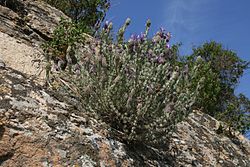- Subshrub
-
A subshrub (Latin suffrutex) or dwarf shrub is a short woody plant. Prostrate shrub is a similar term.
It is distinguished from a shrub by its ground-hugging stems and lower height, with overwintering perennial woody growth typically less than 10–20 cm tall, or by being only weakly woody and/or persisting only for a few years.
Small, low shrubs such as lavender, periwinkle, and thyme, and many members of the family Ericaceae, such as cranberries, are often classed as subshrubs.
Contents
Definition
A chamaephyte or dwarf-shrub is a plant that bears hibernating buds on persistent shoots near the ground – usually woody plants with perennating buds borne close to the ground, no more than 25 centimetres (9.8 in) above soil surface. One significance of the closeness to the ground is that the buds remain within the surface boundary layer and are thus somewhat protected from harsh winter winds.[1]
Chamaephytes are especially important in stressful environments, for example in alpine, arctic or dry ecosystems, often grazed by herbivores, and on nutrient-poor soils or rock.
Examples
Prominent examples are many of the species of maquis and other submediterranean dry ecosystems (such as thyme, Thymus vulgaris, and rosemary, Rosmarinus officinalis), the different heather species (e.g. Calluna vulgaris and Erica species), African wild olive (Olea europaea ssp. cuspidata) and edelweiss (Leontopodium alpinum). The term chamaephyte is particularly used within the context of Raunkiær plant life-forms.
Chamaephytes also include cushion plants.[2]
See also
References
- ^ Dennis M. Gorsuch; Steven F. Oberbauer; Jack B. Fisher; Dennis M. Gorsuch; Steven F. Oberbauer; Jack B. Fisher (2001), "Comparative Vessel Anatomy of Arctic Deciduous and Evergreen Dicots", American Journal of Botany 88 (9): 1643–1649, doi:10.2307/3558409, JSTOR 3558409, PMID 21669698, http://www.amjbot.org/cgi/content/full/88/9/1643
- ^ Molau, U.; Nordenhall, U.; Eriksen, B. (2005), "Onset of flowering and climate variability in an alpine landscape: a 10-year study from Swedish Lapland", American Journal of Botany 92 (3): 422–31, doi:10.3732/ajb.92.3.422, PMID 21652418, http://www.amjbot.org/cgi/content/full/92/3/422

This botany article is a stub. You can help Wikipedia by expanding it.


